Mapping Literacy: the 2019 Penn State Marathon Read
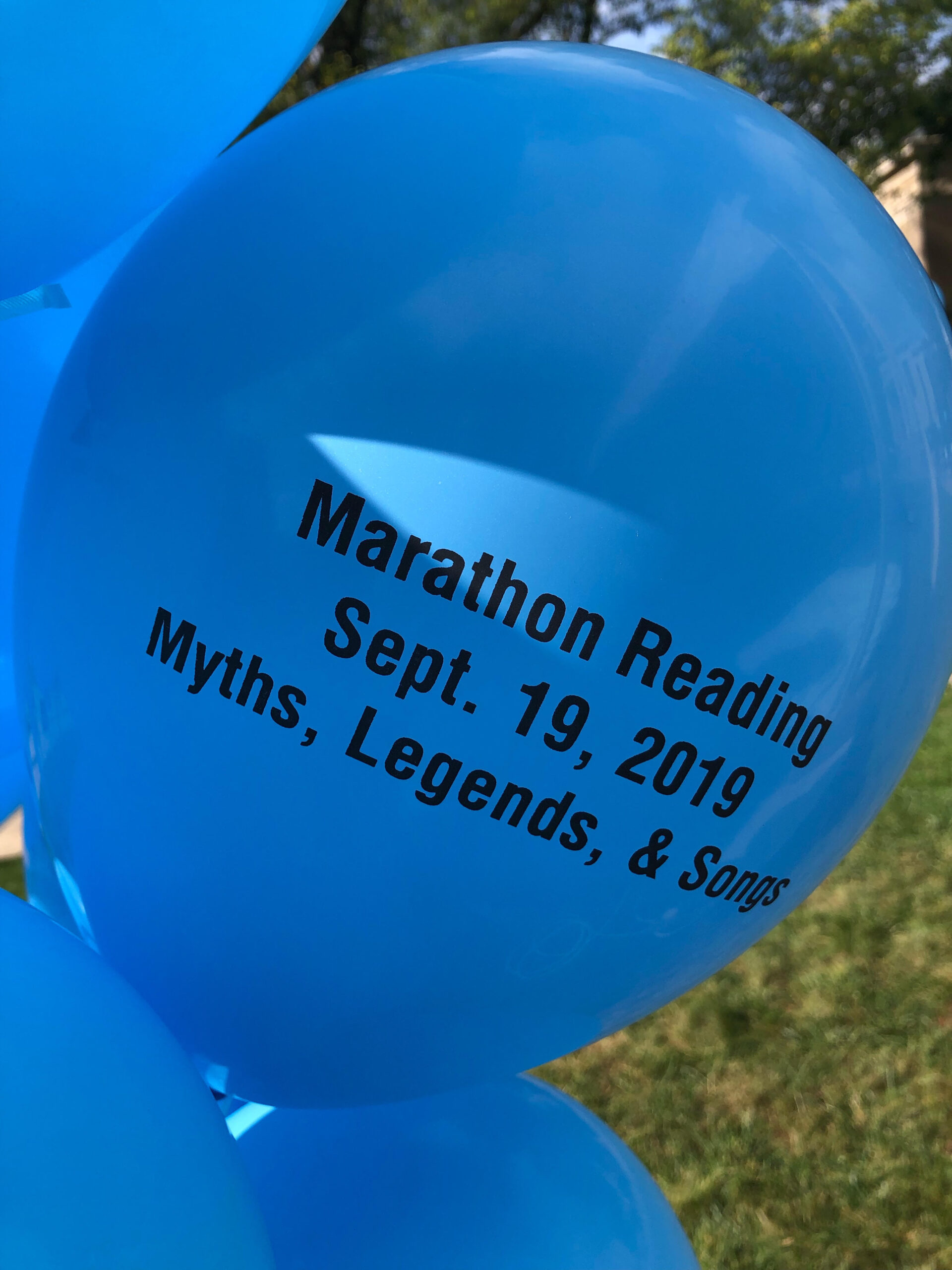
On the green of Pattee Mall, under the white canvas tent, the Penn State Marathon Read of 2019 kicked-off with a bright sun and clear skies. Passersby stopped to see the commotion; students hurrying to class slowed themselves to gaze upon the readers at the podium and listen as they echoed above the rush of the surrounding foot traffic. Under the tent was an array of books such as The Little Mermaid by Hans Christian Andersen, spread on tables, and a multicolored map of the world demanding attention. As the day progressed, the map filled with dazzling star stickers to mark various readers’ hometowns, and by the end of the 12-hour event, 27 countries had been represented. Not only did the read span different stories and languages, illuminating the diverse community on campus, but it also revealed unconventional ways to look at literacy: through song.
This year’s theme celebrated literature from around the world through the genres of myths and legends. Additionally, the Marathon Read featured singing, something not present in recent years. When people think of literature, often they think of novels, stories, and poetry. The Marathon Read challenged those bounds by including songs, which are as capable of evoking emotion as written text is. Towards the end of the night, faculty sang Spanish songs with an accompanying guitar, and one of Penn State’s very own a cappella groups, The Coda Conduct, performed songs in Spanish and Korean. I spoke with Yoo Jin Jeong, one of the lead singers for the club as she described their performance experience at the Marathon Read.
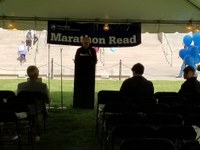
- The first reader of the day reads literature to the attentive audience.
“It’s our first marathon read and we had a fun time performing in front of people who care about diversity and culture,” she said, “and it’s an important event because it enables us to represent languages through song, giving us a chance to present the beauty of them while taking a step in appreciating them.”
The Coda Conduct saw the Marathon Read as a chance to get involved with the community while sharing its members’ individual and collective talents. They are an example of a group whose backgrounds embolden them to try new things, and who give audiences new material that they’ll remember after the performance, just as I did after hearing their beautiful renditions of “24 Hours” and “Que Tiene.” The Coda Conduct’s membership was represented on the map beneath the tent, which both revealed where various readers, and in their case singers, were from and also showed how far Penn State’s community can reach.
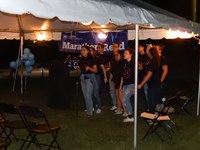
- The Coda Conduct singing one of their two songs of the night.
The global reach of the singing at the Marathon Read was matched by the distinctly international appeal of the myths and stories read aloud by presenters. The Marathon Read is an opportunity to see how wide-spread Penn State’s multifaceted community connections are locally, nationally, and around the world. The Marathon Read offers a chance to witness Penn State students, faculty, and alumni from different backgrounds and origins share stories with one another, from the classic Grimm’s Fairy Tales to “Ithaka” by early twentieth-century Greek poet C. P. Cavafy. The sharing of stories and songs means the sharing of worlds, both literary and personal. The organizers of the Read emphasized smaller, but more numerous texts so that anyone was able to join the reading, rather than focusing on one or two books that came from one department. One of the most powerful elements of this year’s event involved presenters reading texts in many different languages. One story, “Three Drops of Blood” by Sadeq Hedayat, was read in both Persian and English, demonstrating the true internationality of stories.

- A closeup of South America on the world map at the Marathon Read.
In total, I sat at the Marathon Read for two and a half hours and during that time I felt the dynamic of the event from beginning to end. The morning held distinguished faculty and classrooms of students who brought their own material, such as one of Professor Krista Brune’s Portuguese classes reading together. Many people read excerpts in both English and another language, or had a partner with whom to switch off. I was able to sit with Julian Bernhardt, a member of the class of 2020, who was at the Marathon Read for the first time. I wanted to get his perspective as to why he thought the Read was important, and why he wanted to be a part of it.
“[T]he Marathon Read really brings everyone together no matter who you are,” he said, “and it’s important because everyone gets to love reading and culture together for the day.”
I share in his feelings as this event was my first Marathon Read too. Regardless of our inexperience, Julian and I could both feel the weight of what we saw around us. To volunteer or participate at this event is to see the many departments that comprise the College of the Liberal Arts working to combine their strengths to create successful events like the Read. We saw the focused eyes of the onlookers, the tall podium, and the chairs full of people who cared to listen, because listening was creating a lasting connection.
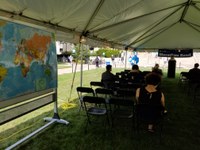
- The crowd listens to an early morning Marathon Reader. To the left is the world map, with only a few stars on it so far.
Going to the Marathon Read was an experience unlike any other I have had. Being a student, schedules are busy with deadlines and weeks flying by. Little of my time is spent taking in the memories I’m making and the moments I’m witnessing. To be a part of an event of this kind of importance, that which creates a lasting impression, makes me glad that I’m a member of the Penn State community, and that I’ve chosen my home here. As a senior, it seems like this last year is moving quickly along, and it is with a sense of relief that I am able to watch it go by and smile as I think of all the people I have met and the events I have helped with so far and will continue to assist with until graduation. The Marathon Read helped me reorient myself as a Penn State student and in the world as a citizen.
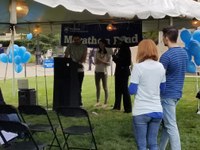
- A trio performing a multilingual reading during the morning of the Marathon Read.
The night didn’t end with a somber myth under the lights of the tent, but rather with the audience up on their feet. The last performance featured songs that were sung by Professor Ady Martínez of the Spanish Department, accompanied by Eric Ian Farmer, a local singer/songwriter and educator on guitar and backup vocals. Professor Martínez insisted that everyone get out of their seats to feel the music, dance and shake the chill that had begun to set in as the sun sank down. As the night grew colder towards the end of the 12-hour event, there were warm smiles and laughs. The map reflected the lights hanging around the tent, as the last few lyrics of the song, the remaining beats of the drum, and the shadows of the dancers performed into being a sense of unity and joy. In the end, all the diversity of language, geography, and genre came together to create one community, and it was community at its finest.
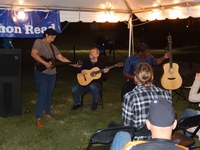
- Professor Martínez setting up with her guitarists to close out the night.

On the green of Pattee Mall, under the white canvas tent, the Penn State Marathon Read of 2019 kicked-off with a bright sun and clear skies. Passersby stopped to see the commotion; students hurrying to class slowed themselves to gaze upon the readers at the podium and listen as they echoed above the rush of the surrounding foot traffic. Under the tent was an array of books such as The Little Mermaid by Hans Christian Andersen, spread on tables, and a multicolored map of the world demanding attention. As the day progressed, the map filled with dazzling star stickers to mark various readers’ hometowns, and by the end of the 12-hour event, 27 countries had been represented. Not only did the read span different stories and languages, illuminating the diverse community on campus, but it also revealed unconventional ways to look at literacy: through song.
This year’s theme celebrated literature from around the world through the genres of myths and legends. Additionally, the Marathon Read featured singing, something not present in recent years. When people think of literature, often they think of novels, stories, and poetry. The Marathon Read challenged those bounds by including songs, which are as capable of evoking emotion as written text is. Towards the end of the night, faculty sang Spanish songs with an accompanying guitar, and one of Penn State’s very own a cappella groups, The Coda Conduct, performed songs in Spanish and Korean. I spoke with Yoo Jin Jeong, one of the lead singers for the club as she described their performance experience at the Marathon Read.

- The first reader of the day reads literature to the attentive audience.
“It’s our first marathon read and we had a fun time performing in front of people who care about diversity and culture,” she said, “and it’s an important event because it enables us to represent languages through song, giving us a chance to present the beauty of them while taking a step in appreciating them.”
The Coda Conduct saw the Marathon Read as a chance to get involved with the community while sharing its members’ individual and collective talents. They are an example of a group whose backgrounds embolden them to try new things, and who give audiences new material that they’ll remember after the performance, just as I did after hearing their beautiful renditions of “24 Hours” and “Que Tiene.” The Coda Conduct’s membership was represented on the map beneath the tent, which both revealed where various readers, and in their case singers, were from and also showed how far Penn State’s community can reach.

- The Coda Conduct singing one of their two songs of the night.
The global reach of the singing at the Marathon Read was matched by the distinctly international appeal of the myths and stories read aloud by presenters. The Marathon Read is an opportunity to see how wide-spread Penn State’s multifaceted community connections are locally, nationally, and around the world. The Marathon Read offers a chance to witness Penn State students, faculty, and alumni from different backgrounds and origins share stories with one another, from the classic Grimm’s Fairy Tales to “Ithaka” by early twentieth-century Greek poet C. P. Cavafy. The sharing of stories and songs means the sharing of worlds, both literary and personal. The organizers of the Read emphasized smaller, but more numerous texts so that anyone was able to join the reading, rather than focusing on one or two books that came from one department. One of the most powerful elements of this year’s event involved presenters reading texts in many different languages. One story, “Three Drops of Blood” by Sadeq Hedayat, was read in both Persian and English, demonstrating the true internationality of stories.

- A closeup of South America on the world map at the Marathon Read.
In total, I sat at the Marathon Read for two and a half hours and during that time I felt the dynamic of the event from beginning to end. The morning held distinguished faculty and classrooms of students who brought their own material, such as one of Professor Krista Brune’s Portuguese classes reading together. Many people read excerpts in both English and another language, or had a partner with whom to switch off. I was able to sit with Julian Bernhardt, a member of the class of 2020, who was at the Marathon Read for the first time. I wanted to get his perspective as to why he thought the Read was important, and why he wanted to be a part of it.
“[T]he Marathon Read really brings everyone together no matter who you are,” he said, “and it’s important because everyone gets to love reading and culture together for the day.”
I share in his feelings as this event was my first Marathon Read too. Regardless of our inexperience, Julian and I could both feel the weight of what we saw around us. To volunteer or participate at this event is to see the many departments that comprise the College of the Liberal Arts working to combine their strengths to create successful events like the Read. We saw the focused eyes of the onlookers, the tall podium, and the chairs full of people who cared to listen, because listening was creating a lasting connection.

- The crowd listens to an early morning Marathon Reader. To the left is the world map, with only a few stars on it so far.
Going to the Marathon Read was an experience unlike any other I have had. Being a student, schedules are busy with deadlines and weeks flying by. Little of my time is spent taking in the memories I’m making and the moments I’m witnessing. To be a part of an event of this kind of importance, that which creates a lasting impression, makes me glad that I’m a member of the Penn State community, and that I’ve chosen my home here. As a senior, it seems like this last year is moving quickly along, and it is with a sense of relief that I am able to watch it go by and smile as I think of all the people I have met and the events I have helped with so far and will continue to assist with until graduation. The Marathon Read helped me reorient myself as a Penn State student and in the world as a citizen.

- A trio performing a multilingual reading during the morning of the Marathon Read.
The night didn’t end with a somber myth under the lights of the tent, but rather with the audience up on their feet. The last performance featured songs that were sung by Professor Ady Martínez of the Spanish Department, accompanied by Eric Ian Farmer, a local singer/songwriter and educator on guitar and backup vocals. Professor Martínez insisted that everyone get out of their seats to feel the music, dance and shake the chill that had begun to set in as the sun sank down. As the night grew colder towards the end of the 12-hour event, there were warm smiles and laughs. The map reflected the lights hanging around the tent, as the last few lyrics of the song, the remaining beats of the drum, and the shadows of the dancers performed into being a sense of unity and joy. In the end, all the diversity of language, geography, and genre came together to create one community, and it was community at its finest.

- Professor Martínez setting up with her guitarists to close out the night.